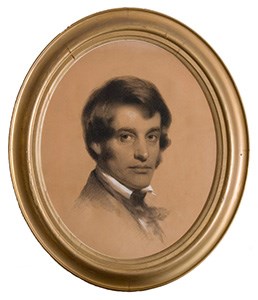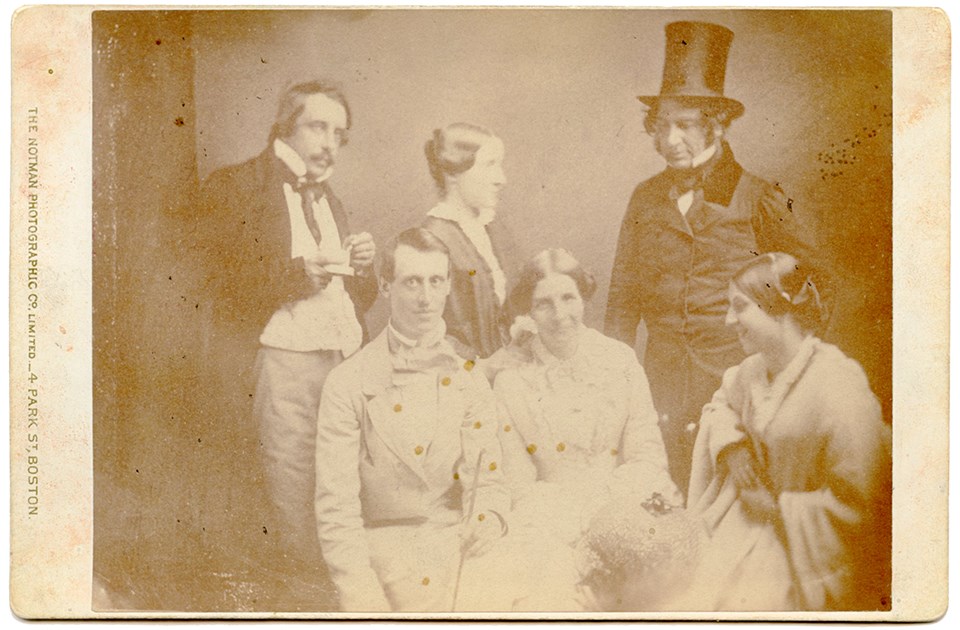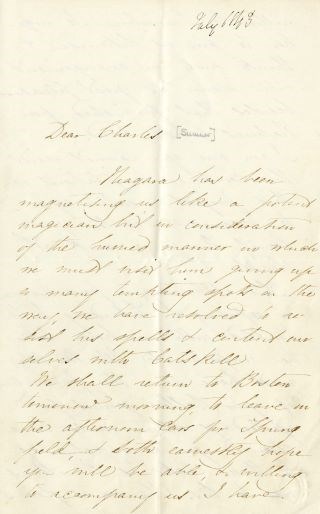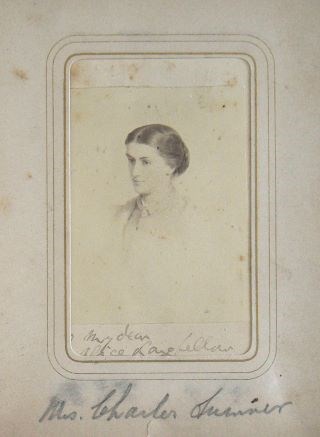Last updated: February 10, 2025
Article
An Era of Romantic Friendships: Sumner, Longfellow, and Howe
Romantic friendship is the term most often used when discussing close intimate relationships, often ambiguous in nature, between two same-sex friends in the 19th century. As social mores allowed men and women to be far more affectionate to members of the same sex than they often are today, the term ranges from platonic physical affection to actual romantic relationships. As homosexuality was taboo at best, illegal at worst, men who we would now consider to be gay or bisexual were not often capable of openly expressing or fully understanding those feelings. After all, in the early 19th century, there were no terms, phrases, or formal community to make sense of the feelings and sensations they experienced.1 Romantic friendships not only encouraged men to make pledges of undying devotion and love, but even allowed for the physical intimacy that many so desperately craved.2
It becomes difficult, then, to parse out what was simply friendship and what was romantic love. What is clear is that these friendships often formed the basis for some of the strongest relationships a person could have. Henry Wadsworth Longfellow’s best friend, Charles Sumner, exemplifies this perfectly. His parallel relationships with Henry Longfellow and Samuel Gridley Howe highlight just how complex these friendships could be.

Museum Collection, Longfellow House-Washington's Headquarters NHS (LONG 545)
Charles Sumner met both Henry Longfellow and Samuel Howe in 1837 – Longfellow at a dinner with a mutual friend, Howe in the middle of a riot. These two friendships proved to be the most important of Sumner’s life. Sumner often spent his Saturdays with Howe, and his Sundays with Longfellow. Throughout the week, the trio found excuses to visit one another at work or at Longfellow’s home. This schedule became a bit of a nuisance to Sumner’s law partner, George Hillard, who ironically complained to Longfellow that Sumner was “quite in love with Howe and spends so much time with him that I begin to feel the shooting pains of jealousy.”3
Sumner, for his part, certainly did not deny his attachment. “I am with Howe a great deal. Bachelors both, we ride and drive together, and pass our evenings, far into the watches of the night, in free and warm communion.” Trouble was brewing on the horizon, though, as he continued, “I think, however, he will be married very soon. What then will become of me? It is a dreary world to travel in alone.”4
This fear was not inherently an overreaction on Sumner’s part. In most cases, the norm of romantic friendships dictated that men were to distance themselves emotionally and physically after they were married. As a wife entered the picture, the intimate friend was relegated to secondary status out of necessity, as Howe himself even hinted at, writing, “I find my heart yearning more and more for something to love even more than I love you my dear Sumner: but till I find it let me be all yours.”5

Longfellow Family Photograph Collection, Longfellow House-Washington's Headquarters NHS (3007.001/002.001-#064)
The “greater love” that Howe found was a young woman named Julia Ward, later famous for her women’s rights activism and for penning the lyrics to ‘Battle Hymn of the Republic’. They were engaged, after a rocky courtship, in February of 1843. Longfellow followed suit that May, finally winning the heart of his beloved Fanny Appleton. It only makes sense, then, that Sumner’s reaction to their engagements was a negative one. “I fear much, dear Henry, that I may have seemed dull & indifferent to your great happiness when you first broke it to me this morning… Howe has gone, & now you have gone, & nobody is left with which I can have sweet sympathy… What shall I do these long summer evenings? And what will become of those Sabbaths, sacred to friendship and repose?”6
Samuel Gridley Howe and Henry Wadsworth Longfellow answered that question in very different ways.
After getting married Howe seemed to swing like a pendulum, alternating between pushing Sumner away entirely one day and doing the same to his wife the next. These mixed signals caused problems for all three of them. Sumner felt that Howe had completely abandoned him, and he fell into a depressive and suicidal spiral. Mutual friends noticed the change immediately, including Longfellow, and quickly wrote Howe hoping that he could help Sumner through his worsening depression. Howe genuinely seemed to try, reassuring him of his affection and their friendship, and desperately ending one entreaty with, “All this sermonizing and exhorting will do no good, I suppose; but I have done what I could. And now, if you will, go on, neglect exercise, neglect sleep, study late and early, stoop over your table, work yourself to death, grieve all your friends and break my heart; for where, dear Charlie, at my time of life, shall I find a friend to love as I love you?”7
Sumner’s response to this plea is lost to history, though it seems Howe’s reassurance did little good, as a few months later Sumner wrote, “I am going to say what will offend you; but what I trust God will pardon… For me there is no future either of usefulness or happiness.”8
Julia Ward Howe, meanwhile, felt her husband had not abandoned his attachment to Sumner enough. When she caught her husband writing Sumner yet another letter of reassurance while on their honeymoon, she exasperatedly joked, “Sumner ought to have been a woman, and you to have married her.” Howe passed that message on to Sumner himself: with the caveat that such a thing would never happen; he was monogamous and marrying both of them would be wrong.9
Perhaps hoping that it would resolve the tension all around, Howe encouraged Sumner to lessen his own affections and get married:
Would you were here now, your straps unbuttoned, your waistband also, your feet in my red slippers, a glass of orvietto in your hand, your sweet smile on your lips, just as you used to sit in my easy chair of a Saturday night- then would I tell you how delightful it is to be married, then would I discourse to you of the deep strong tenderness of a high woman,- of a woman like my Julia… If you see her, more beautiful than ever, with her arms around my neck before, her large eyes flashing light, & love, & happiness, and mine glowing with more than I can show, you will forswear what you are, become as one of us, & make us still happier in witnessing a happiness we have so longed for in you.10
The marriage itself proved a miserable one, for reasons far beyond Sumner’s role. As Julia Ward Howe later wrote about her marriage, “I do not see why one should pretend to be excessively happy when one is not, or why one should try to say to oneself, ‘I love this man,’ when love is a matter out of the question.”11 Her relationship with Sumner, oddly enough, fared slightly better, though it remained tense and often antagonistic.
Sumner and Howe never seemed to fully adjust to the new order of things, though the extent to which their circumstances changed is unknown. When Sumner became a Senator for Massachusetts, Howe wrote him, “I have made a rule lately to put in the only safe place such notes of yours as might be disagreeable to you to have seen by unfriendly eyes- on the grate. It costs me something to burn a piece of paper that has been hallowed to my eye by the impress of your hand, but I do it. I have no confidant for such things- no! not one.”12 Most of Sumner’s letters to Howe are now lost to history because of it, and many of Howe’s letters to Sumner are partially burned or cut to ribbons in return.

Frances Elizabeth Appleton Papers, Longfellow House-Washington's Headquarters NHS
The Longfellow family responded in an entirely different way, embracing Sumner as an unofficial member of the family. It was still a rocky start even for them. Sumner, reeling from the loss of Howe, seemed inconsolable at the prospect of losing Henry Longfellow as well, writing, “I am alone, – alone. My friends fall away from me.”13 Despite Henry Longfellow’s best efforts and continuing assurances of love and affection, it would take the work of Fanny Longfellow herself to avert a total crisis. She involved Sumner in everything, from giving him a prominent role in their wedding to inviting him as a guest on their honeymoon trip. “We shall return to Boston tomorrow morning, to leave in the afternoon cars for Springfield, & both earnestly hope you will be able, & willing to accompany us… Henry promises to appear at the Office by 11 o’clock & hopes to find you with your trunk packed.”14
When the honeymoon ended, Sumner found himself once again facing an uncertain – and potentially lonely – future. He wrote to a mutual friend, “Returned last evening, from a bridal tour with Longfellow and his wife… You will find dear Longfellow married to one who is beautiful and most lovely… As for me, I am very much alone, and altogether a poor creature.”15
Fanny Longfellow quickly resolved that problem as well. When she and her husband returned from the trip, Sumner found himself invited to the first dinner in their new home. She sat him at the head of the table, cementing once and for all his place in their home and in their lives.16
In the coming years, the trio fell into a happy routine, with parties, constant visits to one another, and Sumner staying over every Sunday as a house guest. Rather than losing his close relationship with Henry, Charles Sumner simply gained another with Fanny. It is little wonder that as the friendship blossomed, Sumner cautiously penned an affectionate note to her, writing, “I met Franklin Dexter last evening; who said – ‘so your friend is engaged at last’- I replied simply- ‘my friends.’”17
Much like Howe, Fanny Longfellow also encouraged Sumner to marry, and was active in the hunt to find him a wife of his own. Evidence suggests he was not opposed to her assistance and meddling, and he even briefly attempted a courtship with Julia Ward Howe’s sister, Louisa. Unfortunately, it never worked. Even Fanny Longfellow grew frustrated by Charles Sumner’s unluckiness in courtship, at one point arguing,
Seriously, dear Charles, I grieve to hear you say your life is weary & pray as earnestly as ever for your happiness; more earnestly, I may say, since I know what happiness is - & therefore long to have you make room in your heart for some one worthy of so holy a temple. But I must not entrust this advice to the wings of a letter. When we are by the cosy fireside of Castle Craigie you shall hear how eloquent I can be on the subject.18

Alice Mary Longfellow Papers, Longfellow House-Washington's Headquarters NHS (1007/1-2#27)
Sumner eventually married in 1866, but the marriage proved an unhappy one and ended in a separation a few months later.
In the end, Howe and the Longfellows were the truest and closest family Sumner had. It is impossible to say for certain where on the spectrum of sexual orientation his romantic feelings fell. It is as much a grey area now as it was then. What is clear is that these relationships, vague though they were, were an essential part of Sumner’s world- and the sentiment was very much reciprocated. Longfellow’s affection for Sumner, even after his marriage, never once waned, and the two remained inseparable for the rest of their lives.
Notes
1 Gary Williams, Hungry Heart: The Literary Emergence of Julia Ward Howe, pg 43-44
2 Susan Ferentinos, Interpreting LGBT History at Museums and Historic Sites, pg. 36
3 George Hillard to Henry Wadsworth Longfellow, May 16, 1842, quoted in David Herbert Donald, Charles Sumner and the Coming of the Civil War, pg. 72
4 Charles Sumner to Francis Lieber, June 27th, 1842, Charles Sumner Correspondence, 1829-1874 (MS Am 1). Houghton Library, Harvard University.
5 Samuel Gridley Howe to Charles Sumner, February 1, 1842, Howe Family Papers, 1819-1910 (MS Am 2119). Houghton Library, Harvard University.
6 Charles Sumner to Henry Wadsworth Longfellow, May 12, 1843, Charles Sumner Correspondence, 1829-1874 (MS Am 1). Houghton Library, Harvard University.
7 Samuel Gridley Howe to Charles Sumner, December 1843, Howe Family Papers, 1819-1910 (MS Am 2119). Houghton Library, Harvard University.
8 Charles Sumner to Samuel Gridley Howe, August 16, 1844, Charles Sumner Correspondence, 1829-1874 (MS Am 1). Houghton Library, Harvard University.
9 Samuel Gridley Howe to Charles Sumner, September 11, 1844, Howe Family Papers, 1819-1910 (MS Am 2119). Houghton Library, Harvard University.
10 Samuel Gridley Howe to Charles Sumner, Feb 2, 1844, Howe Family Papers, 1819-1910 (MS Am 2119). Houghton Library, Harvard University.
11 Julia Ward Howe to Louisa Ward, June 13, 1848, quoted in Williams, Hungry Heart, pg. 105.
12 Samuel Gridley Howe to Charles Sumner, April 20th, 1852, Howe Family Papers, 1819-1910 (MS Am 2119). Houghton Library, Harvard University.
13 Charles Sumner to Francis Lieber, July 13, 1843, Charles Sumner Correspondence, 1829-1874 (MS Am 1). Houghton Library, Harvard University.
14 Fanny Longfellow to Charles Sumner, August 7, 1843, in the Frances Elizabeth Appleton Longfellow (1817-1861) Papers, 1825-1961 (bulk dates 1832-1861) (LONG 20257), Longfellow House–Washington’s Headquarters National Historic Site.
15 Charles Sumner to George Washington Greene, August 17, 1843, Charles Sumner Correspondence, 1829-1874 (MS Am 1). Houghton Library, Harvard University.
16 Anne-Marie Taylor, Young Charles Sumner and the Legacy of the American Enlightenment, pg. 159
17 Charles Sumner to Fanny Longfellow, May 18, 1843, Charles Sumner Correspondence, 1829-1874 (MS Am 1). Houghton Library, Harvard University.
18 Fanny Longfellow to Charles Sumner, October 13, 1843, in the Frances Elizabeth Appleton Longfellow (1817-1861) Papers, 1825-1961 (bulk dates 1832-1861) (LONG 20257), Longfellow House–Washington’s Headquarters National Historic Site.
